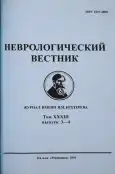State of cerebral hemodynamics in patients with Chiari I malformation
- Authors: Krupina N.E.1,2, Pyshkina L.I.1,2, Kabanov A.A.1,2
-
Affiliations:
- Ural State Medical Academy
- Russian State Medical University
- Issue: Vol XXXIII, No 3-4 (2001)
- Pages: 18-23
- Section: Articles
- URL: https://journals.rcsi.science/1027-4898/article/view/80842
- DOI: https://doi.org/10.17816/nb80842
- ID: 80842
Cite item
Full Text
Abstract
The special features of the cerebral hemodynamics were studied in 138 patients with Chiari I malformation (CM) with a help of magnetic resonance angiography (MRA) and transcranial dopplerography (TCD). MRA data analysis (58) revealed the frequent presence of vertebrobasilar system (VBS) maldevelopment and embryonic type of the circle of Willis. TCD data analysis (100) discovered vertebrobasilar insufficiency and bilateral blood flow increase in the intracranial part of the internal carotid arteries giving evidence of the compensated blood flow from the carotid system to the VBS. 21,0% of patients with CM and communicating hydrocephalia had TCD signs of intracranial hypertension. The most significant changes in cerebral hemodynamics were found in patients with marked pathology and elder than 30 years old.
Keywords
Full Text
##article.viewOnOriginalSite##About the authors
N. E. Krupina
Ural State Medical Academy; Russian State Medical University
Author for correspondence.
Email: info@eco-vector.com
Russian Federation, Ekaterinburg; Moscow
L. I. Pyshkina
Ural State Medical Academy; Russian State Medical University
Email: info@eco-vector.com
Russian Federation, Ekaterinburg; Moscow
A. A. Kabanov
Ural State Medical Academy; Russian State Medical University
Email: info@eco-vector.com
Russian Federation, Ekaterinburg; Moscow
References
- Беленькая Р.М. Инсульт и варианты артерий мозга. — М., 1979.— 176 с.
- Брагина Л.К. О закономерностях коллатерального кровообращения при окклюзирующих поражениях магистральных сосудов головы в зависимости от состояния виллизиева круга (Ангиографическое изучение) // Журн. неврол. и психиатр. — 1967. — № 9. — С. 1293—1299.
- Верещагин Н.В. Патология вертебрально-базилярной системы и нарушения мозгового кровообращения. — М., 1980.
- Гайдар Б.В., Дуданов И.П., Парфенов В.Е., Свистов Д.В. Ультразвуковые методы исследования в диагностике поражений ветвей дуги аорты. — Петрозаводск, 1994.
- Гладилин Ю.А., Сперанский В.С. Корреляция параметров артериального круга большого мозга и главных мозговых артерий и их изменчивость при аномалиях артериального круга // Вопр. нейрохирургии. — 1992. — № 4—5. — С. 29—32.
- Крупачев И.Ф., Метальникова Н.Н. Структура виллизиева круга // Кровоснабжение центральной и периферической нервной системы человека / Под ред. Огнева Б.В. — М.: Издательство АМН СССР, 1950. — С.88—96.
- Никитин Ю.М. Ультразвуковая допплерография в диагностике поражений артерий дуги аорты и основания мозга // Ультразвуковая допплеровская диагностика сосудистых заболеваний / Под. ред. Никитина Ю.М., Труханова А.И. — М.: Видар, 1998. — С.64—115.
- Парамонов Л.В. Аномалия Арнольда—Киари // Сов. медицина. — 1967. — №10. — С.63—67.
- Пышкина Л.И., Федин А.И., Бесаев Р.К. Церебральный кровоток при синдроме позвоночной артерии // Журн. неврол. и психиатр. — 2000. — № 5. — С.45—49.
- Сарибекян А.С. Транскраниальная допплерография при оценке уровня внутричерепного давления // Журн. неврол. и психиатр. — 1994. — № 1. — С.34—37.
- Шахнович А.Р., Шахнович В.А. Диагностика нарушений мозгового кровообращения (транскраниальная допплерография).—М., 1996..
- Шмидт Е.В., Лунев Д.К., Верещагин Н.В. Сосудистые заболевания головного и спинного мозга. — М.: Медицина, 1976. — 284с.
- Gabrielsen Т.О., Seeger J.F., Amundsen Р. Some new angiographic observations in patients with Chiari type I and II malformations // Radiology. — 1975. — Vol. 115. —№.3. — P. 627—634.
- Hill A., Volpe J.J. Decrease in pulsatile flow in the anterior cerebral arteries in infantile hydrocephalus // Pediatrics. — 1982. — Vol.69. — № l. — P.4—7.
- Klingelhofer J., Conrad B., Benecke R., Sander D., Markakis E. Evaluation of intracranial pressure from Transcranial Doppler studies in cerebral disease // J. Neurol. — 1988. — Vol.235. — P.159—162.
- Maki Y., Sueyoshi N., Shiraishi H., Moriya K. Studies of persistent carotid-basilar anastomosis. Report of a case with persistent hypoglossal artery associated with Arnold-Chiari malformation // Clin. Neurol. (Tokyo). — 1965. — Vol. 5. — P.278—285.
- Margolis M.T., Newton Т.Н. An angiographic sign of cerebellar tonsillar herniation // Neuroradiology. — 1971. — № 2. — P.3—8.
- Matsumura М., Nojiri К., Yumoto Y. Persistent primitive hypoglossal artery associated with Arnold-Chiari type I malformation // Surg. Neurol. — 1985. — Vol.24. — №. 3. — P.241—244.
- Mayer P.L., Kier E.L. The ontogenetic and phylogenetic basis of cerebrovascular anomalies and variants // Brain surgery: complication avoidance and management / Ed. Apuzzo M.L.J. — New York: Churchill Livingstone, 1993. — Vol. 1. —P. 691—792.
- Milhorat Th.H., Chou M.W., Trinidad E.M., Kula R.W., Mandell M., Wolpert Ch., Speer M.C. Chiari I malformation redefined: Clinical and radiographic findings for 364 symptomatic patients // Neurosurgery. —1999. — Vol.44. —№.5. — P.1005—1017.
- Moufarrij N., Awad I.A. Classification of the Chiari malformations and syringomyelia // Syringomyelia and the Chiari malformations / Eds. Anson J.A., Benzel E.C., Awad I.A. — Park Ridge: The American Association of Neurological Surgeons, 1997. — P.27—34.
- Padget D.H. The development of the cranial arteries in the human embrio // Embriology and anatomy in intracranial aneurysms / Ed. Dandy W. — New York, 1947. — Vol.1. — P.207—259.
- Rousseaux M., Salomez J.L., Petit H. Syncopes and transitory neurologic manifestations revealing cervico-occipital joint malformations. Evidence of a vascular mechanism // Sem. Hop. — 1983. — Vol.59. —№ 11. — P.729—732.
- da Silva J.A., Brito J.C., da Nobrega P.V., Costa M. do D., de Souza A.B. Surgical findings in 260 cases of basilar impression and/or Arnold-Chiari malformation // Arq. Neuropsiquiatr. — 1994. — Vol. 52. — № 3. — P.363—369.
Supplementary files






